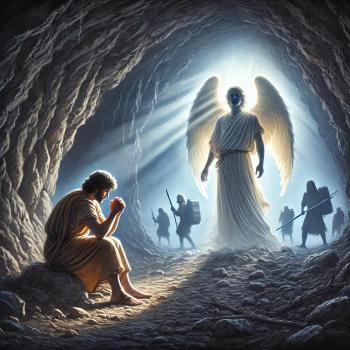Revelation 9:13-21 God’s Judgment Against False Worship
The clear pattern of this judgment is against the false worship of the unbelievers. Even though God sends out an army to stop people, they still engage in false worship.
SEVEN EVENTS THAT OCCUR AT THE SIXTH TRUMPET
1. The Sixth Trumpet Angel announces judgment (Revelation 9:13-14)
“The sixth angel blew his trumpet. From the four horns of the gold altar that is before God, I heard a voice say to the sixth angel who had the trumpet, “Release the four angels bound at the great river Euphrates.”” (Revelation 9:13–14, HCSB)
2. Four angels are released (Revelation 9:15)
“So the four angels who were prepared for the hour, day, month, and year were released to kill a third of the human race.” (Revelation 9:15, HCSB)
Some scholars claim these angels bound at the Euphrates River are demons. I disagree. The reason is because these angels oversee a judgment against unbelievers who are worshiping demons later in the chapter. As a result, I believe that these angels are overseeing this great battle. The Euphrates held spiritual significance and important realities. First, the river symbolizes a vulnerable Roman Empire. Beyond the river lay the Parthian Empire and the world’s finest fighting cavalry. Second, the Euphrates is the eastern boundary of the promised land.1
The first-century Mediterranean world would have especially understood the Euphrates cavalry image. The Roman world feared the crack cavalry forces of the Parthians who came from the region of the Euphrates River in much the same way as the twenty-first-century world would fear the “smart bombs” of the United States. This cavalry force is made up of thousands of strange horselike warriors; yet it is still under the restraint of the Lamb’s authority. Even their destructive power is not total, though they march by the command of God’s angels.2
3. The angels oversee a large army (Revelation 9:16-17)
The army is released at a precise time, for a special purpose: to kill (not just torment) a third of the world’s population. Since a fourth of mankind has already been killed (Revelation 6:8), this means that half of the world’s population will be dead by the time the sixth trumpet judgment is completed.3
The size
“The number of mounted troops was 200 million; I heard their number.” (Revelation 9:16, HCSB)
The figure communicates an “indefinite number of incalculable immensity.” The standing Roman army at this time numbered around 150,000 with an auxiliary army of roughly the same size. The demonic army would be almost 700 times larger than the world’s most powerful army at that time, and John’s first audience would have been shocked and overwhelmed by this number. For today’s equivalent you would need to multiply the number of the world’s largest army by 700. It’s striking to realize how small God’s army (144,000) seems by comparison. The Lord always does his most powerful work through human weakness.4
A large invasion from the East and North in the end times is predicted in Daniel 11:44.5
“But reports from the east and the north will terrify him, and he will go out with great fury to annihilate and completely destroy many.” (Daniel 11:44, HCSB)
The horses
“This is how I saw the horses in my vision: The horsemen had breastplates that were fiery red, hyacinth blue, and sulfur yellow. The heads of the horses were like lions’ heads, and from their mouths came fire, smoke, and sulfur.” (Revelation 9:17, HCSB)
These unusual creatures, which John would have seen or heard about, were similar to other animals: winged bulls and winged lions. They were in use at the time as a sign of sovereignty and ancient military power.6 In the Old Testament the metaphor of “fire and sulphur,” sometimes together with “smoke,” indicates a fatal judgment.7 The closest approximation to these creatures in Greek literature was the horrifying monster called the Chimaera, which had “the head of a lion, the tail of a dragon or serpent, and the body of a goat and belching fire”; in ancient pictures, it could have a lion body with a goat head.8
4. The three plagues sent out by the army (Revelation 9:18)
“A third of the human race was killed by these three plagues—by the fire, the smoke, and the sulfur that came from their mouths.” (Revelation 9:18, HCSB)
5. The destructive power of the tails (Revelation 9:19)
“For the power of the horses is in their mouths and in their tails, for their tails, which resemble snakes, have heads, and they inflict injury with them.” (Revelation 9:19, HCSB)
John now sees the demonic army he had just heard about. The damage is done not by the riders but by their horses, which have heads like lions and tails like snakes. The fire-breathing sea monster Leviathan mentioned in the Old Testament may provide the background for John’s imagery.
“Flaming torches shoot from his mouth; fiery sparks fly out! Smoke billows from his nostrils as from a boiling pot or burning reeds. His breath sets coals ablaze, and flames pour out of his mouth.” (Job 41:19–21, HCSB)
These diabolical creatures spew forth three separate plagues of “fire, smoke and sulfur,” an image often depicting divine judgment in the Old Testament (for example Sodom and Gomorrah).
“Then out of the sky the Lord rained burning sulfur on Sodom and Gomorrah from the Lord.” (Genesis 19:24, HCSB)
“He looked down toward Sodom and Gomorrah and all the land of the plain, and he saw that smoke was going up from the land like the smoke of a furnace.” (Genesis 19:28, HCSB)
“In the same way, Sodom and Gomorrah and the cities around them committed sexual immorality and practiced perversions, just as angels did, and serve as an example by undergoing the punishment of eternal fire.” (Jude 7, HCSB)
The spoken nature of these plagues may indicate a connection with false teaching and deception that encourages people to participate in idolatry and immorality. Most importantly, the comparison to snakes indicates the demonic nature of their attacks that bring suffering and death.9
6. Unbelievers engage in non-repentant false worship (Revelation 9:20)
“The rest of the people, who were not killed by these plagues, did not repent of the works of their hands to stop worshiping demons and idols of gold, silver, bronze, stone, and wood, which are not able to see, hear, or walk.” (Revelation 9:20, HCSB)
A similar list appears in Daniel 5:23.10
“Instead, you have exalted yourself against the Lord of heaven. The vessels from His house were brought to you, and as you and your nobles, wives, and concubines drank wine from them, you praised the gods made of silver and gold, bronze, iron, wood, and stone, which do not see or hear or understand. But you have not glorified the God who holds your life-breath in His hand and who controls the whole course of your life.” (Daniel 5:23, HCSB)
In the Tribulation religious deception and demon worship will reach an all-time high. And yet, even though billions of people will have lost their lives, God’s judgments do not motivate overtly religious people to repent of their sins.11
7. Unbelievers continue in sin despite the judgment of God (Revelation 9:21)
“And they did not repent of their murders, their sorceries, their sexual immorality, or their thefts.” (Revelation 9:21, HCSB)
“Magic arts” makes use of the Greek word pharmakeia, which has come into English as “pharmacy” and developed in part as a result of the ancient practice of the use of hallucinatory drugs in the practice of magic, sorcery, divination, and healing. Sexual immorality (porneia) is the word referring to general sexual licentiousness. Less specific but inclusive of adultery, the term indicates the promiscuous nature of society including the preoccupation of the mind with sexual themes. It is inherently selfish and often abusive.12
One Biblical scholar, Walter Elwell, notes that those who were not killed in the first six plagues learned nothing from their experience. Just as in the case of Pharaoh, who continued to harden his heart as God sent the plagues upon Egypt, so here, mankind refuses to acknowledge God as God.13
FOUR CATEGORIES OF SIN
1. Murder
2. Drug Addiction
3. Sexual Immorality
4. Theft
Here we have the first of three vice lists in Revelation (see also 21:8, which describes those who will experience the second death, and 22:15, which explains who will be excluded from the new Jerusalem). Those without the seal of God continue in idolatry, murdering, magic arts, immorality, and thieving. Four of the five are prohibited in the Ten Commandments (Exodus 20:1–17).
“Magic arts” is listed because it was practices in the local community and it became a challenge for the believers in the church. (Acts 19:19; Galatians 5:19–20; Revelation 18:23; 21:8; 22:15).
The emphasis falls on the sin of idolatry, which is defined here as demon worship (Deuteronomy 32:16–17; 1 Corinthians 10:20).14
Theme: The goodness of God, not the judgment of God, leads unbelievers to repentance.
Hell will be filled with the likes of these men and women one day, for it appears that judgment does not lead to repentance. The rich man remains self-centered and unrepentant in Torment (Luke 16:19-31). Paul writes that it is the goodness of God – not His judgment – that leads to repentance (Romans 2:4) And when all is said and done at the end of time, the sinner remains what he has always been and will always be – unrighteous and filthy (see Revelation 22:11).15
As C.S. Lewis mentioned: ‘God whispers to us in our pleasures, speaks in our conscience, but shouts in our pains.’16 If we will not hear the tremendous voice of the pains of bereavement, there can be no hope for us.17
1 Robert W. Wall, Revelation, Understanding the Bible Commentary Series (Grand Rapids, MI: Baker Books, 2011), 132.
2 Earl F. Palmer and Lloyd J. Ogilvie, 1, 2 & 3 John / Revelation, vol. 35, The Preacher’s Commentary Series (Nashville, TN: Thomas Nelson Inc, 1982), 181.
3 Warren W. Wiersbe, The Bible Exposition Commentary, vol. 2 (Wheaton, IL: Victor Books, 1996), 595.
4 J. Scott Duvall, Revelation, ed. Mark L. Strauss and John H. Walton, Teach the Text Commentary Series (Grand Rapids, MI: Baker Books, 2014), 137–138.
5 John F. Walvoord, “Revelation,” in The Bible Knowledge Commentary: An Exposition of the Scriptures, ed. J. F. Walvoord and R. B. Zuck, vol. 2 (Wheaton, IL: Victor Books, 1985), 953.
6 W. Harold Mare, New Testament Background Commentary: A New Dictionary of Words, Phrases and Situations in Bible Order (Ross-shire, UK: Mentor, 2004), 439.
7 G. K. Beale and Sean M McDonough, “Revelation,” in Commentary on the New Testament Use of the Old Testament (Grand Rapids, MI; Nottingham, UK: Baker Academic; Apollos, 2007), 1115. See for example: Genesis 19:24, 28; Deuteronomy 29:23; 2 Sam. 22:9; Isaiah 34:9–10; Ezekiel 38:22.
8 Craig S. Keener, Revelation, The NIV Application Commentary (Grand Rapids, MI: Zondervan Publishing House, 1999), 271–272.
9 J. Scott Duvall, Revelation, ed. Mark L. Strauss and John H. Walton, Teach the Text Commentary Series (Grand Rapids, MI: Baker Books, 2014), 138. See Beale’s excursus on “The Metaphorical Associations of Serpents and Scorpions in Judaism,” in Revelation, 515–16.
10 Steve Moyise, The Old Testament in the Book of Revelation, ed. Stanley E. Porter, vol. 115, Journal for the Study of the New Testament Supplement Series (Sheffield: Sheffield Academic Press, 1995), 56.
11 Robert Vacendak, “The Revelation of Jesus Christ,” in The Grace New Testament Commentary, ed. Robert N. Wilkin (Denton, TX: Grace Evangelical Society, 2010), 1286.
12 Paige Patterson, Revelation, ed. E. Ray Clendenen, vol. 39, The New American Commentary (Nashville, TN: B&H, 2012), 226–227.
13 Walter A. Elwell, Evangelical Commentary on the Bible, vol. 3, Baker Reference Library (Grand Rapids, MI: Baker Book House, 1995), Re 9:13.
14 J. Scott Duvall, Revelation, ed. Mark L. Strauss and John H. Walton, Teach the Text Commentary Series (Grand Rapids, MI: Baker Books, 2014), 138–139.
15 Rob Philips, “200 Million Mounted Troops: Revelation 9:13-21,” OnceDelivered.net, Internet, https://oncedelivered.net/2012/07/16/200-million-mounted-troops-revelation-913-21/, 16 July 2012, accessed on 19 April 2016.
16 C. S. Lewis, The Problem of Pain (Bles, 1940), p. 81.
17 Michael Wilcock, The Message of Revelation: I Saw Heaven Opened, The Bible Speaks Today (Leicester, England; Downers Grove, IL: InterVarsity Press, 1986), 99–100.












